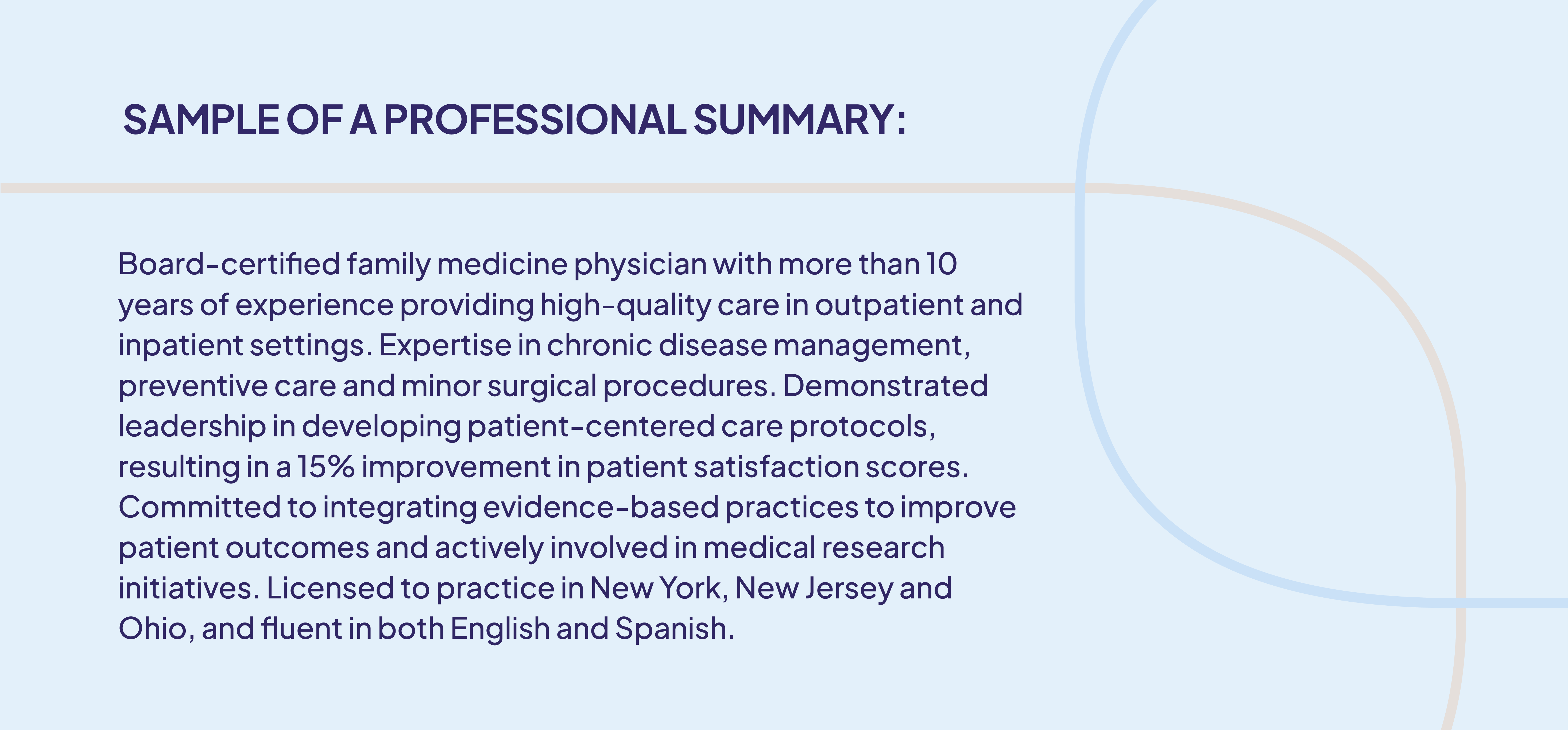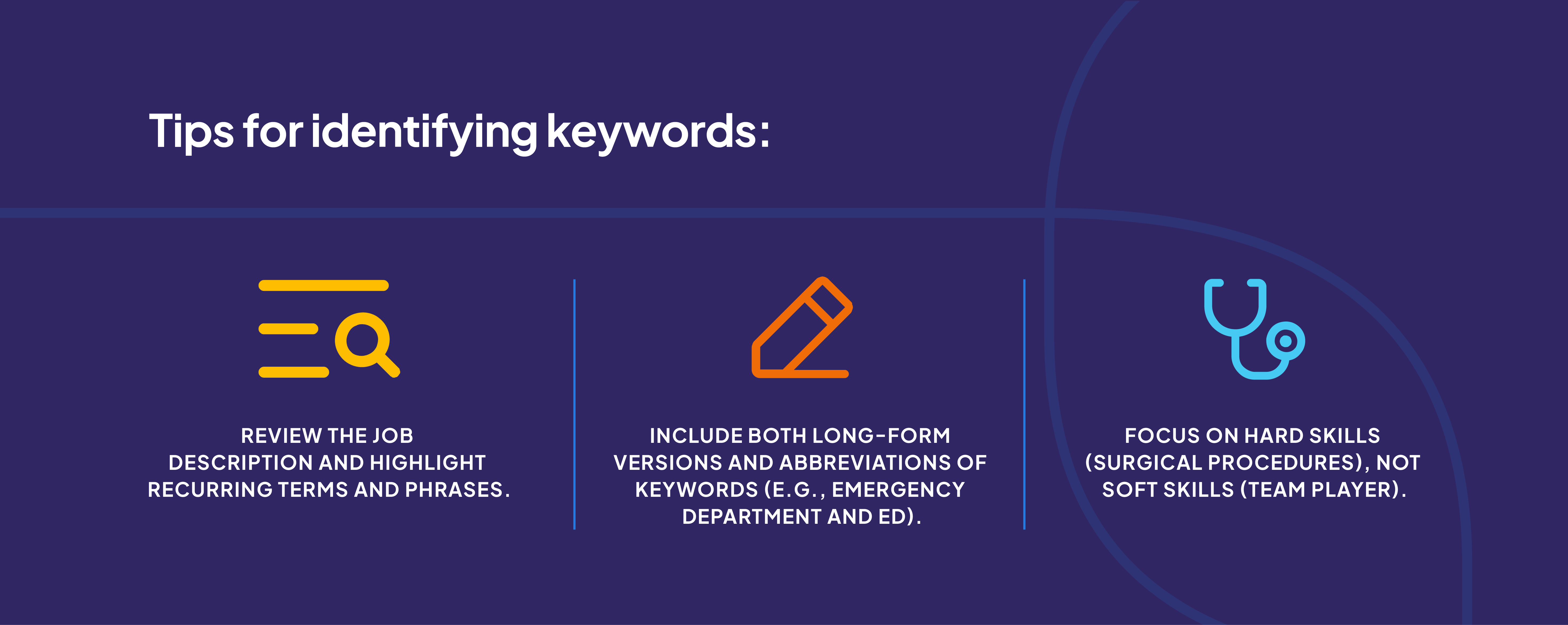Recent Posts
Most Popular
Tips for how to write a medical CV

Summary
- The projected physician shortage (86,000 by 2036) underscores the importance of standing out in a competitive job market, starting with a well-crafted medical CV.
- A comprehensive medical CV should include key sections like clinical experience, education, licenses, and a tailored professional summary, all optimized for ATS compatibility.
- New residency graduates should focus on concise, structured CVs emphasizing clinical rotations, while experienced physicians should highlight leadership roles, locum work, and recent achievements.
- Avoid common CV pitfalls such as poor formatting, irrelevant information, and generic applications. A tailored, keyword-rich CV significantly improves your chances of securing the right opportunity.
According to the U.S. Bureau of Labor Statistics, there is an average of 23,600 job openings for physicians and surgeons projected each year through the close of the decade. Many of those openings are expected to result from the need to replace workers who transfer to different occupations or retire from the field.

Although the projected physician shortage is expected to create numerous opportunities for those entering or staying in the workforce, the job market remains competitive. To stand out, having a well-crafted curriculum vitae (CV) is essential. But, with so many CV templates available, it’s easy to feel overwhelmed by the options.
I’ve designed this article to help simplify the process of writing a medical CV. Here, I cover key points including:
- The medical CV format.
- Tips for new grads.
- CV suggestions for experienced physicians.
- Optimizing for an ATS.
- Common mistakes to avoid.
So, what are the key components of a medical CV?
Creating a compelling medical CV involves more than listing your qualifications and experience. Each section should be carefully crafted to present your professional story while meeting both applicant tracking system (ATS) and recruiter expectations. But whether you are writing your first CV as a new graduate or updating one following years of experience, it should include the following elements:
- Personal Information - should be straightforward and easy to locate. Include your full name, professional title, contact information and LinkedIn profile.
- Professional Summary – is the introduction to your CV that provides a snapshot of your qualifications and career goals.
- Clinical Experience – is one of the most important sections of your medical CV. Specify your rotations, residencies, fellowships and other relevant clinical work, in reverse chronological order. Include the institutions, dates of service, your role, and a brief description of your duties and achievements.
- Skills and Competencies – should list any specialized skills that are relevant to the job you’re applying for. Items here could include specific medical procedures performed or technological competencies.
- Education and Training – should also be listed in reverse chronological order. Start with your most recent degree and include names of institutions, locations, degrees obtained and dates of attendance.
- Licenses and Certifications – should be sectioned out, in detail. Include all relevant medical licenses and certifications, along with the issuing body, license number and expiration date. If you are board-certified in a specialty, highlight it here.
- Research and Presentations – are crucial inclusions for those in academic or research-oriented roles. List research projects you’ve been involved in, and publications, presentations, or papers you’ve authored or co-authored. Don’t forget the titles, publication names and dates.
- Professional Affiliations – should include your memberships in relevant professional organizations or specialty-specific societies.
Include additional sections if you have honors or awards, volunteer experience, or multiple language proficiencies. Also add a note at the bottom that references are available upon request.
Be sure to tailor sections to match the skills described in the job description, when and where appropriate, to best highlight your qualifications for individual opportunities.
Use our curriculum vitae template to help you get started.
Writing a CV summary
It is important to understand what to include and avoid when writing a professional summary for a medical CV. Be sure your summary is at the top of your CV and is concise, keeping it between 3-5 sentences. Briefly note your experience, skills and strengths, and professional objectives. Avoid using medical jargon and generic phrases and do not include personal information, like hobbies. Also, be sure to customize your summary for each position you apply for, focusing on your attributes that align with the job description.

CV tips for new residency grads
Starting early with a well-organized CV will help you build a strong foundation that can be updated easily as you progress through your career. For more extensive CV dos and don’ts, along with other tips to kick-off your medical career, download our free Resident Career Guide.
- Be structured: Organize your CV with standard sections (like those above) to keep it clean, professional and easy to read.
- Keep it concise: Since this is your first CV, aim for no more than two pages in length.
- Focus on clinical experience: Emphasize rotations, responsibilities and skills acquired. Demonstrate your depth of knowledge and adaptability to different settings.
- Don’t get personal: Avoid including things that are irrelevant to the role you are applying for.
- Go beyond clinical duties: Add any leadership roles or volunteer work you participated in as a resident to reflect your initiative, teamwork and ability to balance responsibilities.
CV suggestions for experienced physicians
Seasoned physicians should maintain a comprehensive, up-to-date CV. Doing so ensures any new accomplishments, certifications or roles are captured promptly, avoiding the rush to recall details when new opportunities arise.
- Update regularly: Even with years of experience, physicians should review and update their CV every few months — quarterly if possible.
- Keep it fresh: Remove outdated information and add new achievements as you progress. Any experience that does not demonstrate relevant skills from more than 10 years ago should be removed.
- Highlight leadership experience: With time, your CV should increasingly emphasize leadership, mentorship and/or committee roles, to demonstrate career progression beyond clinical work.
- Include locum work: If you’ve had experience as a locum tenens, be sure to include each assignment, as they demonstrate that you have a variety of experience and adaptability.
Optimizing for an ATS
Employers use ATS software to streamline recruitment processes. By automatically filtering, organizing and ranking applications based on specific criteria, an ATS can quickly match keywords and phrases from job descriptions to submitted CVs. Most employers use ATSs to screen applications, so designing your CV with specific keywords, formatting and structure that align with the system's requirements is crucial. Failure to do so could result in your application being filtered out before a human recruiter ever sees it.
Learn more about ATS optimization.

Common CV mistakes to avoid
- Don’t overload it with too much information. Focus on relevant experience and accomplishments directly related to the job you’re applying for.
- Don’t ignore the job description, which provides a roadmap for what the employer is looking for. Failing to incorporate the required skills and experience can significantly reduce your chances of being considered.
- Don’t make poor design choices. It might be tempting to use creative formatting, but this often backfires – especially with ATS.
- Don’t use the same generic CV for all applications. Tailor your CV for each opportunity, playing up your strengths and experiences that align with each role.
With a well-structured, tailored, informative and keyword-rich CV, you'll be well-positioned to stand out and land the physician position you deserve. When you’re ready to begin your search, visit DocCafe to view thousands of active opportunities. Or, if you have at least a year of experience, see what exciting locum assignments are available through our partners at Aya Locums. Whatever your career goals are for the future, remember that investing time and effort into crafting and maintaining a compelling medical CV will pay off in the long run.
Tips for how to write a medical CV FAQs
I’m a new medical graduate. What should I include on my first medical resume?
Highlight your education, clinical rotations, residency experience, certifications, and any research or volunteer work. Focus on demonstrating your skills, adaptability and eagerness to contribute to patient care.
As a seasoned physician, how can I showcase my extensive experience without creating an overwhelming resume?
Use a reverse chronological format and include a "Summary of Qualifications" section. Focus on key roles, accomplishments and specialized skills, while leaving off less relevant or outdated information.
Should I include non-clinical experience on my resume?
Yes, if it demonstrates transferable skills or leadership experience. For both new grads and seasoned physicians, non-clinical experiences can highlight versatility.
What certifications and licenses are essential to list?
Include all relevant state medical licenses, board certifications, DEA certification and any specialty-specific credentials. For new grads, listing in-progress certifications is also acceptable.
How do I tailor my resume for locum tenens roles versus permanent positions?
For locum tenens, emphasize flexibility, diverse clinical settings and short-term assignments you've completed. For permanent positions, focus on long-term roles, continuity of care and team integration. Both should highlight adaptability and patient-centered care.
All information, discussions and opinions contained within this blog or otherwise on the website or any linked materials (“the “Blog Content”) is for general informational purposes only. All Blog Content is based on the author's opinions and experiences and is not necessarily representative of our opinions as an organization. It should not be considered as tax/financial advice, legal advice, compliance advice, health advice or other professional advice and does not constitute the practice of any medical, nursing or other professional healthcare advice, diagnosis or treatment or provision of legal services. You should seek professional assistance for any concerns or issues. If you or any other person has a medical concern, you should consult with your healthcare provider or seek other professional medical treatment immediately. While we strive to provide accurate and up-to-date information, we make no warranties or representations regarding the completeness, reliability, or accuracy of the Blog Content. Your use of the Blog Content is solely at your own risk and we will not be liable for any damages or losses arising from the use of, or reliance on, any Blog Content.





 Mike York
Mike York

Comments